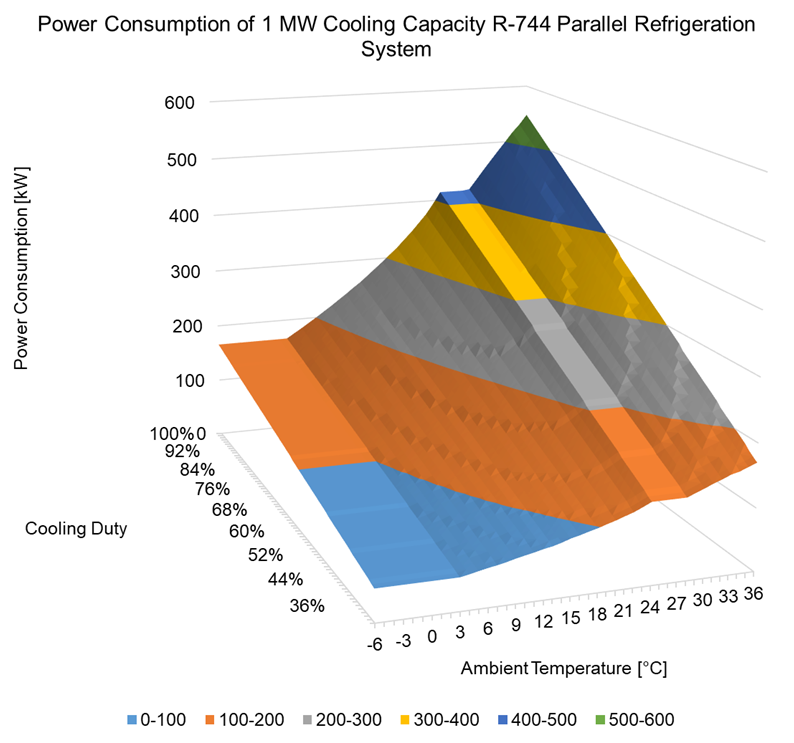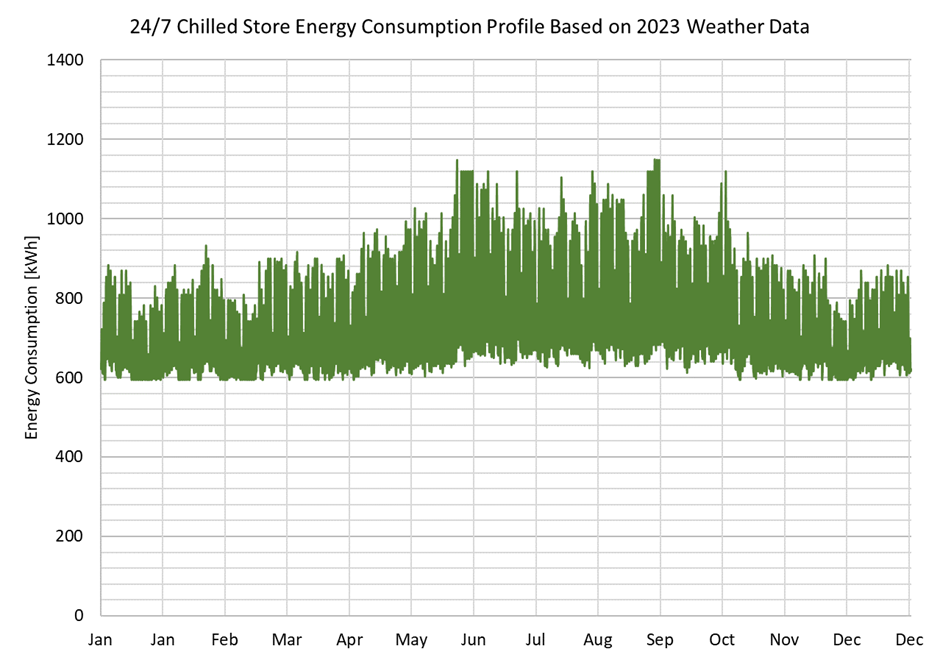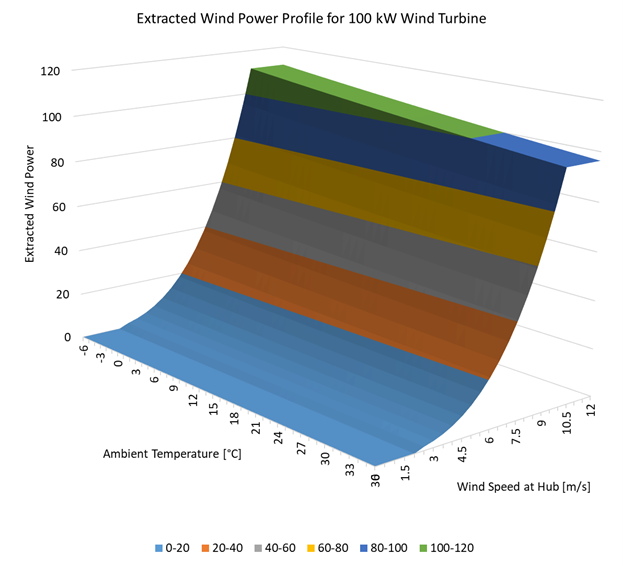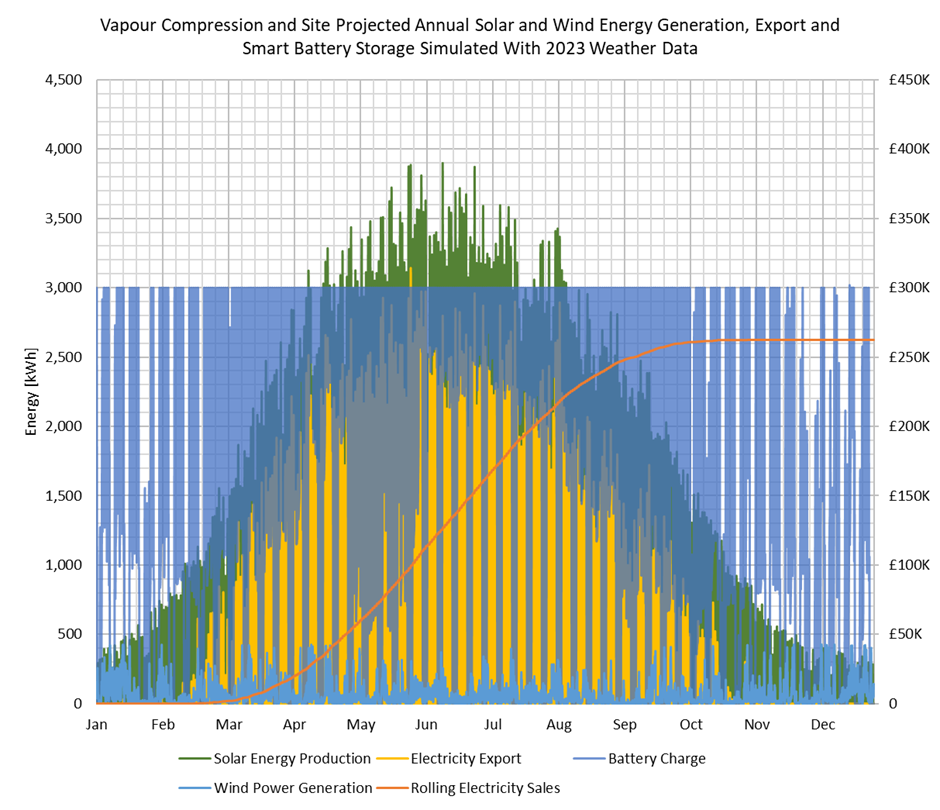Technical Insight – Chilled Store using Renewable Energy!
12th August 2024
Operating a new chilled store with integrated solar array.
Every day, we are reminded about the impact past and present human activity has influenced Climate Change. Our technology and demand for additional energy in a relatively short period has intensified global greenhouse gas (GHG) emissions. In the UK, there has been a gradual decline in GHG emissions to produce and distribute electricity, reducing from 494.26 gCO2e/kWh in 2014 to 207.05 gCO2e/kWh in 2024 but, with the ultimate goal of net zero GHG emissions by 2050, further steps must be taken.
WAVE was recently asked to consider the construction of a new 24/7 chilled store facility, designed for 2 MW cooling capacity in a 509,256 m3 volume. The overall building footprint was provided as 36,240 m2 and designed with a double, 15° pitched roof.
Figure 1 below illustrates the proposed chilled store building shell as a sketch.

Figure 1 – Indicative sketch of the proposed chilled store shell. The doors and windows are for illustrative purposes only.
Refrigeration
Using WAVE’s bespoke refrigeration design and simulation software, the energy consumption of two R-744 parallel refrigeration systems were simulated over the course of a year, represented by 2023 weather data and a variable daily cooling load profile extrapolated from historical operations.
The total annual refrigeration energy consumption was simulated to be 2,115 MWh and the additional site energy consumption from small power electrics and lighting was estimated to be 4,311 MWh. Figure 2 and Figure 3 below illustrates the power consumption profile of the designed refrigeration systems and annual energy consumption profile respectively.
Figure 2 – 1 MW R-744 parallel refrigeration system power consumption profile.
Figure 3 – Annual energy consumption profile for the proposed chilled store.


To contemplate the optimal financial and environmental impact of the proposed chilled store with and without self-generated renewable electricity, further considerations must be understood.
DUoS
Distribution Use of System (DUoS) charges typically apply to commercial and industrial users connected to the UK National Grid. The charges apply a different unit cost for energy depending on the hour, day of the week, month and year as negotiated. Typically, the unit cost of electricity is highest when it is nationally, at its greatest demand. This is usually 4pm ~ 7pm during weekdays but will vary by user and region.
In addition to the DUoS charges, Triad charges may apply where the three largest half hour electricity readings between November and February are averaged and charged a fixed value per kW. Considering when it is optimal to use self-generated electricity, it is critical to understand the variable electricity cost profile so the maximum benefit can be achieved. Table 1 below lists the example DUoS profile used in this study.
Table 1 – Example DUoS charge profile.

The additional electricity charges considered include:
- Standing Charge: 302.46 p/meter/day
- Capacity Charge: 85.34 p/kW/day
- Triad Charge: £60.66 /kW
Further charges not considered as they can only be calculated with a live and fully operational system include exceeded capacity and reactive power charges.
Solar Array
The proposed roof construction provides a total roof top area of 37,518 m2 and it is orientated so the roof pitches face bearings of 150 and 330 (SE and NW). Assuming a solar array installation will cover 75% of the available area, the available solar energy generation is staggering. The following solar panel credentials were simulated alongside half hour 2023 weather data for the proposed location:
- Panel Efficiency: 24%
- Temperature Coefficient: -0.34 %/K
- Power Tolerance: 5%
- Panel Area: 1.5 m2
There is a potential 4,864 MWh annual solar energy generation based on 2023 dry bulb temperature and cloud cover profiles. Although not all of it can be used on-site but excess that cannot be used or stored can be exported at a negotiated rate.
Wind Power
Wind power is often overlooked for self-generated power usually because it is assumed that farm installations are the only viable option, but this is a false assumption. For the proposed chilled store, there is the possibility of installing a 100-kW horizontal axis turbine in each of the site’s four corners and harness 546 MWh of wind energy annually. The wind turbines considered had the following additional characteristics:
- Hub Height: 26 m
- Blade Length: 13 m
- Power Coefficient: 0.32
- Cut-in Speed: 2.5 m/s
- Rated Wind Speed: 10 m/s
- Cut-out Wind Speed: 35 m/s
Figure 3 below illustrates the extracted wind power profile for the selected wind turbine at various wind speeds and dry bulb temperatures.

Figure 4 – Extracted wind power profile for selected 100 kW wind turbine.
Smart Battery Discharge
The suggested self-generated renewable electricity plants need a storage system to maximise the benefit as they will not generate electricity all the time, and they are heavily dependent on local weather conditions. By matching the generation profile with the DUoS and refrigeration load profiles, an optimum and controlled discharge of stored electricity will maximise the financial benefit of the systems while reducing the chilled store’s running GHG emissions.
For the electricity storage, a 3,000-kWh battery was simulated and the period when electricity cost the most was prioritised for stored electricity use, followed by the medium priced period afterwards. The optimal control will vary greatly by DUoS agreements. Figure 4 below layers the annual profile of the chilled store renewable energy generation, battery storage charge and discharge, and excess electricity export sales based on 2023 weather data.

Figure 5 – Proposed chilled store renewable energy generation annual profile with rolling electricity export sales.
The simulation assumes the site’s electricity consumption matches the simulated profile for the refrigeration system and 24/7 occupation. The electricity export was sold at a fixed 11 p/kWh rate.
Result
The proposed site with renewable electricity generation and storage suggests the annual operational electricity cost can be reduced from £2,213,140 to £247,037 per annum.
Despite the presence of excess renewable energy that is simulated to be exported to the National Grid, the production of the excess energy does not align with the period when it is needed, but not available, hence, a continued reliance on the National Grid.
These are typically the winter months in the UK and visible on Figure 4 above between November and February. During the winter months, there are more “still” days with reduced or no wind speed, and the Sun light period is shorter while also transitioning the sky at a lower elevation; limiting solar power potential.
Regardless, the annual financial benefit of £1,966,103 cannot be ignored. With an estimated capital cost of £10,891,642 for the solar array, wind turbines and battery storage, the investment will pay for itself within 5.5 years, or 28% of its lifetime.
The annual environmental impact of the site electricity consumption switches from a harmful 1,331 TCO2e emissions to a negative, yes, negative 239 TCO2e emissions. By exporting the excess energy, the site will reduce the entrained National Grid emissions elsewhere; the exported energy emission cancelation can be considered.
By installing renewable energy systems at this chilled store, operational costs are reduced by 89%, paid for itself in 5.5 years and become a carbon negative site. Over a 20-year lifetime, the financial benefit will be +£25 million.
If you made it this far, or just skipped to the end the message is the same, self-generated renewable energy cannot be ignored. Assess your sites, build a business case, deliver net zero.


